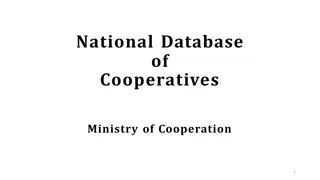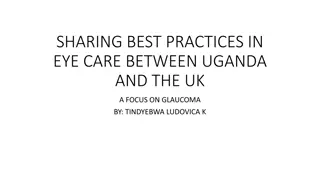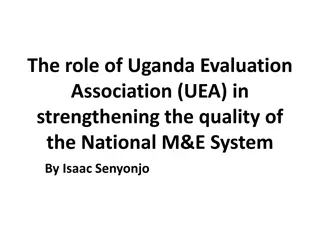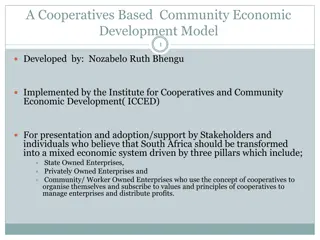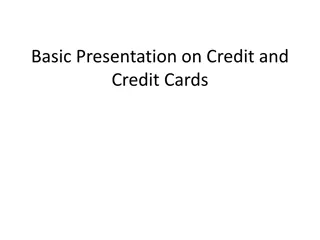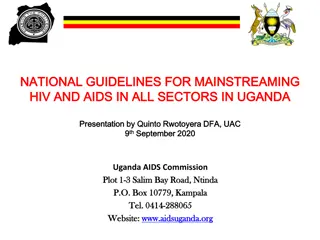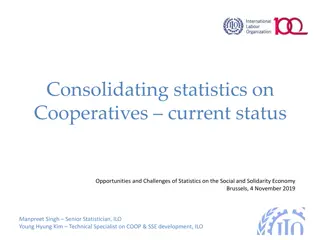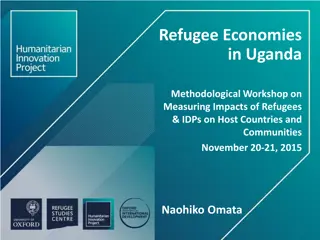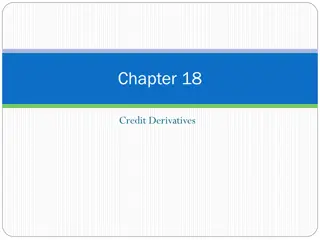Impact of Savings and Credit Cooperatives on Household Welfare in Uganda
Global poverty reduction is a key focus of Sustainable Development Goals, with financial inclusion playing a significant role. This study focuses on the impact of Savings and Credit Cooperative Organizations on member households in Uganda, evaluating access to services and their influence on household welfare using Propensity Score Matching. The importance, challenges, objectives, and governance issues surrounding SACCOs in developing countries are highlighted.
Download Presentation

Please find below an Image/Link to download the presentation.
The content on the website is provided AS IS for your information and personal use only. It may not be sold, licensed, or shared on other websites without obtaining consent from the author. Download presentation by click this link. If you encounter any issues during the download, it is possible that the publisher has removed the file from their server.
E N D
Presentation Transcript
Impact of Savings and Credit Cooperatives on Household Welfare in Uganda Barnabas Kiiza (PhD) George Omiat (PhD) RESDEV CONSULT LTD P.O. Box 10376 Kampala Email: resdevconsult.ltd@gmail.com abkiiza@gmail.com gwomiat@gmail.com Tel:+256-782-156-828
1.0 Global poverty reduction is among key focus points of Sustainable Development Goals (SGDs). Introduction Poverty reduction & improved access to financial markets by households are two very closely related phenomena. Financial exclusion from traditional financial services is widespread in developing countries. In Africa, less than 20% of households have access to formal credit (Beck et al., 2009). In last 30 years microfinance emerged to address this gap. Improved access to microfinance by HHs leads to increase & diversification of incomes; generation of human and social capital; as well as asset accumulation.
Introduction contd Our study focuses on impact of Savings and Credit Cooperative Organizations member households in Uganda. In Uganda, the government has encouraged the formation of SACCOs to increase outreach and access to financial services. Estimates show by 2010 SACCOs in Uganda had:- Outstanding loans of Shs 292 billion (US$132.73 million); Net savings of Shs 208 billion (US$94.55 million); Share capital of Shs 178 billion (US$80.91 million); Income of Shs 60 billion (US$27.27 million). (SACCOs) on welfare of By 2013 there were 1,900 operational SACCOs in Uganda.
Introduction contd Objectives of a typical SACCO include:- Promoting welfare & economic interests of members; providing savings & credit facilities at favorable interest rates; training members in business skills; poverty reduction and cooperation. Importance and Challenges of SACCOs SACCOs legally constituted, but not controlled by Central Bank were a second option to commercial banks by adults holding an account at a financial institution (EPRC, 2013). 61% of all users of SACCOs were women; 87% of all adult users of SACCOs were in rural areas of Uganda (EPRC, 2013). Governance remains the major weakness of SACCOs in developing countries (including Uganda) (Labie & P rilleux, 2008; Cuevas & Fischer, 2006; Cornforth, 2004; B Branch & Baker, 2000)
2.0 We evaluate impact of access to SACCO services on HH welfare by controlling for potential differences between the treatment & control cases using Propensity Score Matching method(PSM). Sample restricted to HHs that use the services & actually save in SACCOs only (treatment cases); Compare them with HHs that do not use the services nor save in in banks, microfinance institutions, SACCOs, etc (control cases). Indicator variable for participation in SACCOs is D = 1 for participants and D = 0 for non-participants. Observed mean outcome, Y under the condition of participation is given as E [Y1|D = 1]. Observed mean outcome, Y under the condition of non- participation , E [Y0|D = 0]. The Unobserved Counterfactual, E[Y0|D = 1]. Methodology
Methodology contd We want average treatment effect on the treated HHs (ATT) where ATT = E [Y1|D = 1] - E [Y0|D = 1] (For participants). In practice we use Observed mean outcome for non-participants E[Y0|D = 0] to proxy Counterfactual outcome, E[Y0|D = 1]. We use PSM to match participants and non-participants in terms of observed characteristics, such as age, education, income, assets, etc, etc. We estimate ATT = E [Y1|D = 1] - E [Y0|D = 0]. Treatment Effects Model We also test whether participation in SACCOs is endogenous using Wu-Hausman test. We find it s endogenous and then use two-step treatment effects model that controls for hidden selection bias.
Treatment effects model uses the two step procedure with the participation first stage probit model as:- Di= xi+ zi+ + vi The predicted values of probit model are used in the second stage OLS regression given by: Yi= xi+ IVD + i(Outcome equation) The Impact of Participation is given by coefficient IV D = 1 for participants and D = 0 for non-participants is the inverse Mills ratio/hazard function, a corrective term for sample selection bias. Instrument variables are in the vector zi, are assumed to be correlated with participation in SACCOs, D, but not with the error vector i.
3.0 Our study uses HH survey data from the World Bank s Living Standards Measurement Surveys (LSMS) for Uganda. The LSMS for Uganda is the Uganda National Panel Survey (UNPS). We use UNPS data for periods 2009/2010 and 2010/2011. The 2009/2010 UNPS sample had 2,975 HHs. The 2010/2011 UNPS sample had 2,716 HHs. We restrict our analysis to the 2009/2010 and 2010/2011 UNPS HH data due to availability of detailed info on HH participation in financial services. Indicator Variable D=1 for SACCO saving HHs;those holding savings in a SACCO only and not in banks or MFIs; (Treatment Group). HHs that do not use the services of nor save in banks, microfinance institutions, SACCOs; D = 0 (Control Group) The DATA
Outcome Variables Household Dietary Diversity Score (HDDS) with 12 main food groups with the same weight (WFP and FAO 2012; Kennedy et al., 2011). Maximum Score = 12 HHDS measures access to food & nutrition. We modified HHDS average No. of food categories eaten by a HH last seven days prior to the survey. Food groups:-(a)cereals; (b)pulses/legumes; (d)vegetables; (e)fruit/juices; (f)meats, poultry, offals, blood; (g)fish types; (h)eggs; (i) milk/milk products; (j)oils/fats; (k)sugar/honey; (l) coffee, tea, condiments. to (c)roots/tubers; Food Consumption Score (FCS) composite score of 8 major food groups eaten by HH in last 7 days; after being weighted & then multiplied by the No. of Days food group was eaten. Maximum Score =112 Food groups:-(a)staples(cereals/tubers),weight=2; (b) pulses/legumes, weight=3; (c)vegetables, weight=1; (d) fruits/fruit juices, weight=1; (e)meats,poultry,fish,offals,weight=4; (f) milk/milk products,weight =4; (g) sugar/honey, weight=0.5; (g)oil/fats,weight=0.5. (WFP & FAO 2012; Kennedy et al., 2011).
Outcome Variables contd Annual household expenditure on clothing and footwear computed for each HH for the 2009/2010 and 2010/2011 surveys. School enrollment ratio computed as sum of children in primary, secondary & tertiary institutions divided by the total number of dependent children in the household. 4.0 Results Impact of SACCOs on HDDS and FCS Access to SACCO savings services has a positive effect on the household dietary diversity score (HDDS). TheATT estimate is statistically significant. 2009/2010 & 2010/2011 samples show when a household chooses to engage in SACCO savings services, on average, their HDDS increases by 10.70% and 11.70%, respectively.
Results contd When a HH chooses to engage in SACCO savings services, on average, their mean FCS increases by 19% due to inter- temporal flexibility in consumption smoothing opportunities provided by SACCOs. Findings are in tandem with RCTs by Ksoll et al. (2016) in Malawi; by Beaman, et al. (2014) in Mali; by Dupas and Robinson (2013) in Kenya. HH savings in Village Savings & Loan Associations (VSLAs) in Malawi; in community based savings groups in Mali & Kenya; results are:- HH Savings have a positive impact on food expenditure; that is, savings have a positive effect on food security and quality. In Uganda vulnerable HHs self-insure against idiosyncratic risks across periods by holding precautionary savings in the form of relatively liquid assets (Kiiza & Pederson, 2006).
Results contd Impact of SACCOs on HH Clothing and Footwear Difference between average yearly HH expenditure on clothing & footwear for SACCO participants and non-participants is Shs 90,000 (US$41). Difference is statistically significant. In Table 4 we show the mean HH size of SACCO participants is not statistically different from that of non-participants upon matching the two cohorts. After Kernel matching, mean HH size for the non-participants in 2010/2011 sample is 7.880. That of participants is 8.351. Difference between two means not significant; p-value = 0.272.
Results contd Impact of SACCOs on School Enrollment Rates Our study shows that HHs with savings in a SACCO have higher school enrollment rates than non-participant HHs. Difference is statistically significant. Holding savings at SACCOs is expected to decrease probability of being liquidity constrained across periods. This inter-temporal flexibility increases likelihood of marginal increments in long-term investments in education of children.
Table 2a: Impact of SACCOs on HH Welfare: Sample of 2010/2011 Method and Outcome ATT t-value No. Matched Pairs No. Treatment Effects Model HDDS 0.876*** 4.12 155 Kernel Matching 1.006*** 3.37 Nearest Neighbor Matching 0.894*** 4.27 Radius Matching Treatment Effects Model FCS 0.976*** 2.58 -0.550a 1228 8.565*** 5.02 155 Kernel Matching 8.323*** 3.60 Nearest Neighbor Matching 8.845*** 4.27 Radius Matching Treatment Effects Model 8.200** 2.01 -0.540a 1228 Note: ***,**,* indicate significance at 1%, 5%, and 10%, respectively. indicates the value of ? at 5% level of significance. indicates the value of ? at 10% level of significance. a denotes the t-value for Lambda in the hazard function of the treatment effect model. Exchange Rate; US$1.00 = Shs 2,200
Table 2b: Impact of SACCOs on HH Welfare: Sample of 2010/2011 Method and Outcome ATT T-value No. Matched Pairs No. Treatment Effects Model Clothing Expenditure (Shs) 83,761*** 5.00 154 Kernel Matching 88,306*** 2.78 Nearest Neighbor Matching 87,198*** 5.25 Radius Matching 87,667** 1.77 -0.380a 1228 Treatment Effects Model School Enrollment Ratio 0.088*** 2.44 105 Kernel Matching 0.078** 1.89 Nearest Neighbor Matching 0.087*** 2.49 Radius Matching 0.113** 1.94 -1.00a 1228 Treatment Effects Model Note: ***,**,* indicate significance at 1%, 5%, and 10%, respectively. indicates the value of ? at 5% level of significance. indicates the value of ? at 10% level of significance. a denotes the t-value for Lambda in the hazard function of the treatment effect model. Exchange Rate; US$1.00 = Shs 2,200
Table 3a: Impact of SACCOs on HH Welfare: Sample of 2009/2010 Method and Outcome ATT t-value Hidden Bias (?) No. Matched Pairs No. Treatment Effects Model HDDS 0.804*** 2.72 1.75 1.95 1.35 1.50 1.70 1.90 0.280a 94 Kernel Matching 0.894** 2.23 Nearest Neighbor Matching 0.770*** 2.74 Radius Matching Treatment Effects Model FCS 0.710** 1.93 605 6.485*** 2.61 1.35 1.50 1.20 1.30 1.40 1.50 -0.550a 90 Kernel Matching 6.447** 1.91 Nearest Neighbor Matching 6.580*** 2.77 Radius Matching Treatment Effects Model 6.427** 1.80 605 Note: ***,**,* indicate significance at 1%, 5%, and 10%, respectively. indicates the value of ? at 5% level of significance. indicates the value of ? at 10% level of significance. a denotes the t-value for Lambda in the hazard function of the treatment effect model. Exchange Rate; US$1.00 = Shs 2,200
Table 3b: Impact of SACCOs on HHD Welfare: Sample of 2009/2010 Method and Outcome ATT T-value Hidden Bias (?) No. Matched Pairs No. Treatment Effects Model Clothing Expenditure (Shs) 92,666*** 2.36 1.60 1.75 2.65 2.95 1.55 1.70 -0.830a 94 Kernel Matching 124,210*** 4.05 Nearest Neighbor Matching 91,316*** 2.49 Radius Matching 90,378** 2.19 605 Treatment Effects Model Note: ***,**,* indicate significance at 1%, 5%, and 10%, respectively. indicates the value of ? at 5% level of significance. indicates the value of ? at 10% level of significance. a denotes the t-value for Lambda in the hazard function of the treatment effect model. Exchange Rate; US$1.00 = Shs 2,200
Table 4: Clothing & Footwear Expenditure: Matched HH Size Means 2010/2011 Sample Non-SACCO HH Size 7.880 8.214 7.770 2009/2010 Sample Non-SACCO HH Size 7.533 7.511 7.510 Method SACCO HH Size 8.351 8.351 8.351 p-value 0.272 0.736 0.178 Kernel Matching Nearest Neighbor Matching Radius Matching Method SACCO HH Size 7.585 7.585 7.585 p-value 0.907 0.858 0.867 Kernel Matching Nearest Neighbor Matching Radius Matching
Table 5: HDDS Kernel Matching Results of Sample HH Characteristics Variable Treated HH Income (Shs) 1,000,000 910,000 HH Head Age 45.62 HH Head Education 8.66 HH Head Work Exp 19.17 Location Dummy 0.245 Control p-value 0.751 0.576 0.892 0.932 0.905 44.81 8.58 19.03 0.239 0.802 0.801 HH Head Gender 0.813 Cooks with Firewood Exchange Rate: US$1.00 = Shs 2,200 Location (Urban=1; Rural=0) HH Head Gender (Male=l; Female=0) Cooks with Firewood (Yes=1;No=0) 0.815 0.989 0.800
5.0 We use propensity score matching and two-step treatment effects models. Results are similar. Tests show Confounding Factors Not a Serious Problem in our ATT estimations(Differences in Mean Outcomes). Conclusions SACCOs play key role in HH food security; clothing & footwear expenditure; school enrollment. SACCOs important in poverty alleviation and don t need substantial investment in physical & institutional infrastructure like that required by traditional microfinance organizations. Many SACCOs face:(a) Poor financial management & capacity; (b)Poor bookkeeping; (c) Inadequately skilled staff and boards (BoU,MoFPED,2017). Given SACCOs importance to vulnerable HHs, thus need for supervision of SACCOs thru Monetary Authorities to improve SACCO service provision.




